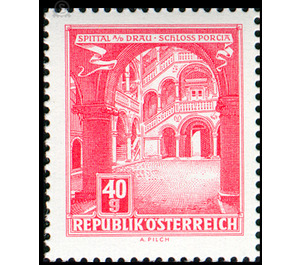Structures - Austria / II. Republic of Austria 1962 - 1 Euro
Theme: Architecture
| Country | Austria / II. Republic of Austria |
| Issue Date | 1962 |
| Face Value | 1.00 |
| Color | orange |
| Printing Type | offset |
| Stamp Type | Definitive |
| Item Type | Stamp |
| Chronological Issue Number | 455 |
| Chronological Chapter | OOS-OE2 |
| SID | 419116 |
| In 81 Wishlists | |
The settlement Spittal owes its existence to the hospice (Spittl), which the counts Hermann and Otto von Ortenberg had founded in 1191 here for the Katschberg riders and equipped with a small church. Already in 1242 Spittal is called as a market. When the sex of the Ortenbergers died out in 1420, their mountain castle was also abandoned and was subsequently abandoned to decay. That is why their successors built a residence, the Schloss zu Spittal, in the Spittal market. The noble Porcia from Friuli were for centuries the lords of the castle and gave him his name. Castle Porcia gave Spittal its historical profile and cultural and historical significance. For the visitor, Porcia Castle gives the impression of an Italian palace. The north façade is particularly impressive in all its well-balanced harmony, its fine structure, with its Venetian-Lombard arched windows and balconies, and the splendidly equipped Prunktor. Impressive for the viewer is also the arcade court, which reminds of the lightness and elegance of Florentine courtyards. Today, the castle also serves a varied cultural program, with which the leaders of the Spittal community duly continue the cultural tradition of this place.


